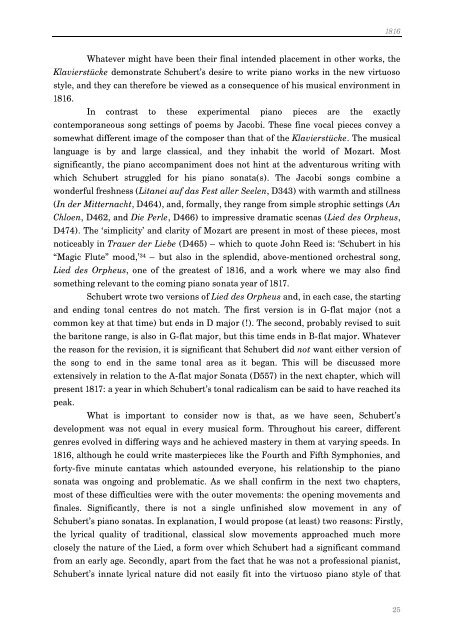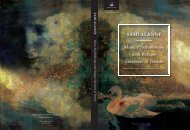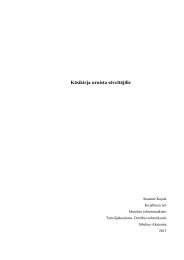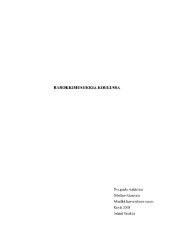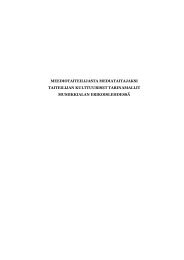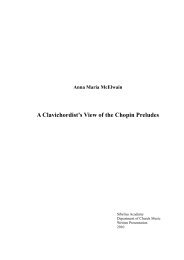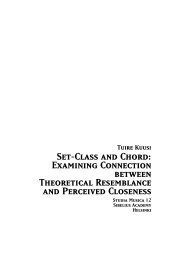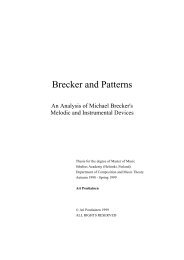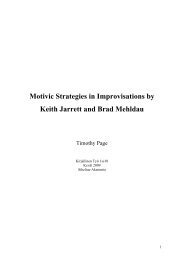The Unfinished Piano Sonatas of Franz Schubert Javier ... - Ethesis
The Unfinished Piano Sonatas of Franz Schubert Javier ... - Ethesis
The Unfinished Piano Sonatas of Franz Schubert Javier ... - Ethesis
Create successful ePaper yourself
Turn your PDF publications into a flip-book with our unique Google optimized e-Paper software.
1816<br />
Whatever might have been their final intended placement in other works, the<br />
Klavierstücke demonstrate <strong>Schubert</strong>’s desire to write piano works in the new virtuoso<br />
style, and they can therefore be viewed as a consequence <strong>of</strong> his musical environment in<br />
1816.<br />
In contrast to these experimental piano pieces are the exactly<br />
contemporaneous song settings <strong>of</strong> poems by Jacobi. <strong>The</strong>se fine vocal pieces convey a<br />
somewhat different image <strong>of</strong> the composer than that <strong>of</strong> the Klavierstücke. <strong>The</strong> musical<br />
language is by and large classical, and they inhabit the world <strong>of</strong> Mozart. Most<br />
significantly, the piano accompaniment does not hint at the adventurous writing with<br />
which <strong>Schubert</strong> struggled for his piano sonata(s). <strong>The</strong> Jacobi songs combine a<br />
wonderful freshness (Litanei auf das Fest aller Seelen, D343) with warmth and stillness<br />
(In der Mitternacht, D464), and, formally, they range from simple strophic settings (An<br />
Chloen, D462, and Die Perle, D466) to impressive dramatic scenas (Lied des Orpheus,<br />
D474). <strong>The</strong> ‘simplicity’ and clarity <strong>of</strong> Mozart are present in most <strong>of</strong> these pieces, most<br />
noticeably in Trauer der Liebe (D465) – which to quote John Reed is: ‘<strong>Schubert</strong> in his<br />
“Magic Flute” mood,’ 34 – but also in the splendid, above-mentioned orchestral song,<br />
Lied des Orpheus, one <strong>of</strong> the greatest <strong>of</strong> 1816, and a work where we may also find<br />
something relevant to the coming piano sonata year <strong>of</strong> 1817.<br />
<strong>Schubert</strong> wrote two versions <strong>of</strong> Lied des Orpheus and, in each case, the starting<br />
and ending tonal centres do not match. <strong>The</strong> first version is in G-flat major (not a<br />
common key at that time) but ends in D major (!). <strong>The</strong> second, probably revised to suit<br />
the baritone range, is also in G-flat major, but this time ends in B-flat major. Whatever<br />
the reason for the revision, it is significant that <strong>Schubert</strong> did not want either version <strong>of</strong><br />
the song to end in the same tonal area as it began. This will be discussed more<br />
extensively in relation to the A-flat major Sonata (D557) in the next chapter, which will<br />
present 1817: a year in which <strong>Schubert</strong>’s tonal radicalism can be said to have reached its<br />
peak.<br />
What is important to consider now is that, as we have seen, <strong>Schubert</strong>’s<br />
development was not equal in every musical form. Throughout his career, different<br />
genres evolved in differing ways and he achieved mastery in them at varying speeds. In<br />
1816, although he could write masterpieces like the Fourth and Fifth Symphonies, and<br />
forty-five minute cantatas which astounded everyone, his relationship to the piano<br />
sonata was ongoing and problematic. As we shall confirm in the next two chapters,<br />
most <strong>of</strong> these difficulties were with the outer movements: the opening movements and<br />
finales. Significantly, there is not a single unfinished slow movement in any <strong>of</strong><br />
<strong>Schubert</strong>’s piano sonatas. In explanation, I would propose (at least) two reasons: Firstly,<br />
the lyrical quality <strong>of</strong> traditional, classical slow movements approached much more<br />
closely the nature <strong>of</strong> the Lied, a form over which <strong>Schubert</strong> had a significant command<br />
from an early age. Secondly, apart from the fact that he was not a pr<strong>of</strong>essional pianist,<br />
<strong>Schubert</strong>’s innate lyrical nature did not easily fit into the virtuoso piano style <strong>of</strong> that<br />
25


